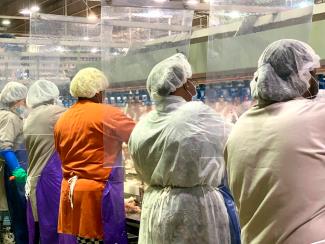 A recent report produced and circulated by Oxfam America claims that U.S. broiler integrators are "backsliding" over protection of workers from COVID. Established facts clearly indicate that most broiler producers were proactive in devising and implementing protective measures including distancing, installation of barriers between workstations and providing PPE at the outset of COVID. Incidence rates among workers in poultry processing plants compare favorably with corresponding records of infection in red meat plants and other industries.
A recent report produced and circulated by Oxfam America claims that U.S. broiler integrators are "backsliding" over protection of workers from COVID. Established facts clearly indicate that most broiler producers were proactive in devising and implementing protective measures including distancing, installation of barriers between workstations and providing PPE at the outset of COVID. Incidence rates among workers in poultry processing plants compare favorably with corresponding records of infection in red meat plants and other industries.
Tom Super of the National Chicken Council condemned the Oxfam report as a "union propaganda piece". He stated, "the health and safety of the essential employees working to keep chicken on our tables has and continues to be the industry's number one priority".
 As with welfare and humane handling of live chickens, the health and safety of workers is critical to maintaining production volume and profitability. The industry has collectively modified procedures by staggering shifts, implementing additional sanitation, decontamination, employee education and providing PPE and workstation barriers. Following a sharp increase in incidence rate in April when COVID-19 emerged, cases have fallen precipitously attesting to the measures implemented by the industry. Some of the Oxfam allegations may have been valid in April, but they are certainly exaggerated or distorted in relation to practices reflecting the Industry from late May onwards.
As with welfare and humane handling of live chickens, the health and safety of workers is critical to maintaining production volume and profitability. The industry has collectively modified procedures by staggering shifts, implementing additional sanitation, decontamination, employee education and providing PPE and workstation barriers. Following a sharp increase in incidence rate in April when COVID-19 emerged, cases have fallen precipitously attesting to the measures implemented by the industry. Some of the Oxfam allegations may have been valid in April, but they are certainly exaggerated or distorted in relation to practices reflecting the Industry from late May onwards.
It is extremely difficult to differentiate between community and plant-acquired infection. This is especially the case in some areas in southern states where clusters have emerged. Detailed epidemiologic evaluations of community and plant-related infection have yet to be conducted. Unfortunately processing of chicken is not an activity that can be conducted from home and the concentration of workers in a plant is unfortunately necessary to maintain production.
It is however evident that a higher level of mechanization and robotics will be required going forward to reduce manual labor in processing. Technology is available, but the relatively low wage rates and availability of workers has inhibited capital investment in automation. With higher rates, bonuses and support costs per worker including testing, PPE and sick leave, the pendulum is swinging in the direction of mechanization and technology. This is currently in use in the EU where availability of workers and their wage rates have predicated mechanization.